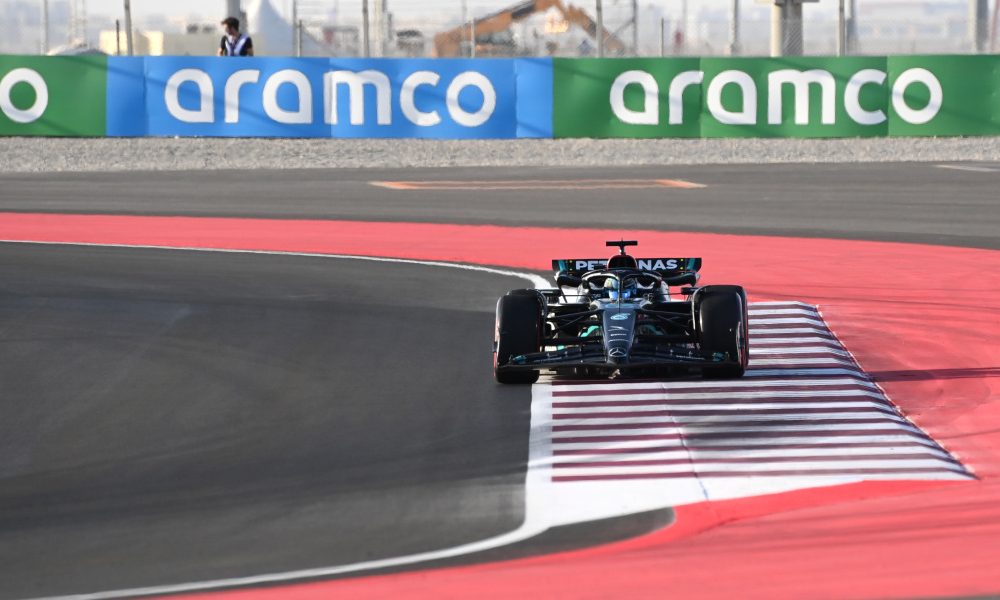Pirelli has explained that changes to the curbs and the time drivers are spending on them have created indications that there could be safety issues at the Qatar Grand Prix.
The FIA has moved the track limits on the exit of Turn 12 and Turn 13 inside the existing exit curb by 80cm to prevent drivers running over the highest part of the curb that stands at 50mm. That’s in response to small initial hints at damage that were discovered by Pirelli after Friday practice, with the tire supplier concerned that use of the tires in the same way for more than 20 laps could lead to a construction failure in the race.
[lawrence-auto-related count=3 category=1388]
Pirelli’s head of motorsport Mario Isola says the discovery was made during the standard post-session checks on Friday night and action had to be taken due to the potential safety permutations.
“Starting yesterday after free practice, as usual we collect several sets of tires,” Isola said. “They have to return one set of tires they used during free practice. We analyzed the sets. We saw an indication that in the construction of the tire on the sidewall, there was a small, small separation between the carcass cord and the topping compound.
“Obviously then we went deeper into the analysis, and this is due to strong impact against, or repeated impact against something. We believe that it is an impact against a curb. The geometry of the curbs we have here is similar to the geometry of the curbs we had in 2021, the second row of the curbs. And in 2021, we had a similar issue.
“So once we have seen this indication, obviously the first step was to inform the FIA to make them aware and find a solution. Maybe it’s because yesterday in free practice, all the drivers were running wide, they had low grip, and it was difficult to find the real line on the track. But our duty is to inform immediately if there is a potential issue. So with tires that we used yesterday and we analyzed were in the range of 20 laps, there is just the initiation (of an issue).
“But tomorrow, the race is 57 laps, and that means we that we need to understand better after the Sprint if with this additional track limits decided by the FIA, the problem is fixed or not. Probably the corners that are stressing the tire the most are Turns 12, 13 or 14. We have to spend a lot of time on the curbs.
“It’s not just the geometry of the curbs, because these curbs are used in many other circuits. It’s the time and the speed of staying on the curbs that is important. So here, during the lap, all the drivers are spending quite a lot of time at high speed on the curbs, and this is damaging the construction.”
The new track limits will remain in place for the rest of the weekend but if analysis after the 19-lap Sprint race show the issue to still be developing then maximum stint lengths will be imposed for Sunday’s race, as well as three mandatory pit stops. The choice of three stops rather than two has been made to ensure strategic variability is possible, rather than all teams being locked into the exact same stints.
F1 races in Qatar two years ago and Isola says the 13-inch tires that were used in 2021 were not necessarily more resistant to the issue than the current 18-inch specification, but that the way the curbing has changed in the two years since has created the problem.
“A smaller sidewall for sure is not helping this effect, because you have less opportunity to absorb the heat. But in general, when we made some specific test on the 18-inch tires, we realized that the level of resistance on the construction was in line with the 13 inches. So we are not saying that the 13-inch tire is weaker compared to the previous tire.
“The point is that in 2021, this was the second row, and so when they were going out, the first row was 25mm, and the second row was 50mm. Now we have only one row that is 50mm. So they jump over the curb and they go down. That’s probably why we found out this issue in free practice, or luckily, we found out this issue in free practice.
“I believe it’s a good example of predicting an issue, and also working with the other stakeholders in order to avoid any safety issues during a race. Better to discover in advance.
“Just to be completely clear, if I cut a tire and I show you the section, you cannot see any damage. It’s so small, that obviously we can find the damage with a microscope. So it’s not an issue that here I’m saying, ‘guys pay attention because we have a big issue’. No. It’s an indication, but obviously we cannot ignore it. That’s why I reported what we found after our analysis.
“I don’t want to talk about fault. There is an issue and we have to work together to fix the issue. Then obviously you learn from issues and for the future we have to find a better process to anticipate it. But it’s important that if there is an issue that is not predicted then we have a system that is happening before we have any tire issue on track and we can fix it, even if we have to change the schedule or the track limits or whatever.”
